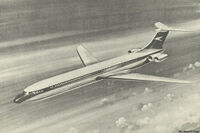
A Vickers Type 1180 Superb, the double decker version of the VC10, in flight.
The Vickers VC.10 is a long-range British airliner designed and built by Vickers-Armstrongs Ltd, and first flown at Brooklands, Surrey, in 1962. The airliner was designed to operate on long-distance routes from the shorter runways of the era, and demanded excellent hot and high performance for operations from African airports. The performance of the VC.10 was such that it achieved the fastest London to Toronto crossing of the Atlantic by a jet airliner, a record still held to date for a sub-sonic airliner; only the supersonic Concorde was faster. The VC.10 is often compared to the larger Soviet Ilyushin Il-62, both aircraft having a rear-engined quad layout, the two types being the only airliners with such a configuration.
In the mid 1960s, Vickers developed an improved version of the VC10, the Type 1150 Super VC.10, which featured more powerful Rolls-Royce Conway engines and a 28 foot (8.54 meter) fuselage stretch offering up to 212 seats, 23 more than the Seattle AF S707-320. The Type 1150 entered service in early 1969 and ceased production in 1985.
In the mid to late 1960s, a double decker version of the VC.10, the Type 1180/1181 Superb, with seating for 250-300 passengers was developed. It entered service in the early 1970s with several airlines around the world. The Type 1180 was 202 feet (61.57 meters) long, had a wingspan of 147 feet 5 inches (44.93 meters), a height of 42 feet (12.8 meters). The VC.10 Superb also replaced the RR Conway engines with the Rolls-Royce RB211 high-bypass turbofans which reduced specific fuel consumption and increased range to 6,000 nautical miles. In 1987, Vickers introduced an improved Superb, the Type 1190, with more powerful and efficient engines, a supercritical wing, and a glass cockpit, reducing the flight crew needed to two. The VC.10 Superb continues to be produced today, having outlived the base VC.10-which ceased production in 1977-though increasing competition from wide-body twinjets such as the Airbus A330 and Vickers's own VC.14 and VC.16 has thrown its future into doubt.
Variants[]
- Standard VC-10
- Vickers VC-10-1100
- Prototype
- Vickers VC-10-1101
- Vickers VC-10-1102
- Vickers VC-10-1104
- Vickers VC-10-1106 C.1
- Vickers VC-10-1107 K.1
- Vickers VC-10-1112 K.2
- Vickers VC-10-1125
- Proposed variant for Aerolineas Argentinas
- Vickers VC-10-F3
- Cargo variant of the Vickers VC-1102
- Super VC-10
- Vickers Super VC-10-1150
- Prototype
- Vickers Super VC-10-1151
- Vickers Super VC-10-1152
- Vickers Super VC-10-1154
- Vickers Super VC-10-1157
- Vickers Super VC-10-1158
- Vickers Super VC-10-1161
- Vickers Super VC-10-1162
- Vickers Super VC-10-1163
- Vickers VC-10-1164 K.3
- Vickers VC-10-1166 K.3A
- Vickers VC-10-1170 K.4
- Vickers Super VC-10-F3
- Cargo variant of the Vickers Super VC-10-1152
- VC-10 Superb
- Vickers VC-10 Type 1180 Superb
- Vickers VC-10 Type 1180 Superb F4
- Vickers VC-10 Type 1180 Superb SP
- Vickers VC-10 Type 1181 Superb
- Vickers VC-10 Type 1181 Superb F4
- Vickers VC-10 Type 1190 Superb
- Vickers VC-10 Type 1190 Superb F4
- Vickers VC-10 Type 1191 Superb
- Vickers VC-10 Type 1191 Superb F4
- Vickers VC-10 Type 1185 Superb CC.1
- VIP Transport variant for the RAF